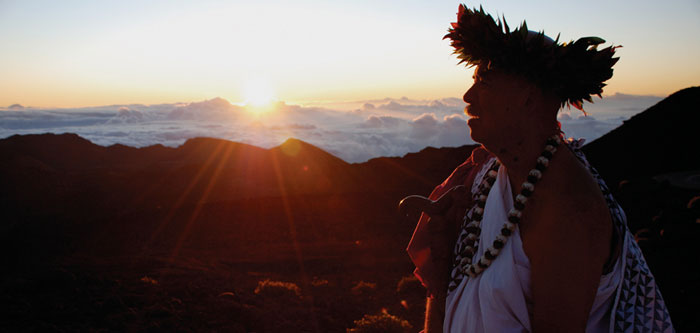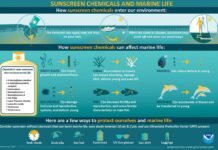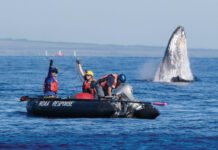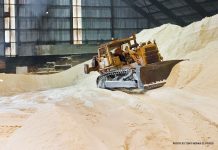Story by Shannon Wianecki | Photo by Soul Fabric Films
 “When is a site too sacred to be built upon?” asked Kaleikoa Ka‘eo, a Hawaiian-studies professor at Maui Community College. “Would you even consider building a telescope on Machu Picchu, Mount Fuji, or Mount Zion?”
“When is a site too sacred to be built upon?” asked Kaleikoa Ka‘eo, a Hawaiian-studies professor at Maui Community College. “Would you even consider building a telescope on Machu Picchu, Mount Fuji, or Mount Zion?”
Ka‘eo’s questions drew applause at a rowdy 2006 public meeting in Paukakalo, where plans to construct the world’s largest solar telescope on the summit of Haleakala came under fire. Three years later, the Advanced Technology Solar Telescope (ATST) is closer to becoming a reality, despite sustained and passionate opposition from the community expected to host it.
If built, the groundbreaking telescope will rise 143 feet from Maui’s tallest peak. Its 13-foot-diameter mirror will be capable of detecting the sun’s magnetic fields and surface phenomena with greater clarity than ever before possible. National Solar Observatory astronomers call the ATST “the biggest leap in our capability to study the sun since Galileo.”
The Observatory proposed the $274 million project to the National Science Foundation, a federal agency that funds cutting-edge science. If approved, the ATST will take four years to build and could achieve first light by 2017.
Jeff Kuhn, the associate director of the University of Hawai‘i’s Institute for Astronomy, says it could revolutionize our understanding of Earth’s closest star, recalibrate our ideas about climate change, and allow us to predict and defend ourselves from solar storms.
While highly anticipated by solar scientists, the new telescope is seen as a scourge by many island residents. Native Hawaiians, wildlife biologists, and wilderness advocates contend that the ATST’s construction will desecrate one of Hawai‘i’s most significant natural and cultural treasures, endanger rare native species, and further erode the spiritual underpinnings of the Hawaiian people.
Observatory researchers evaluated seventy-two sites around the globe before declaring Haleakala the premier location for the ATST. According to their studies, no other spot on Earth possesses Haleakala’s dust-free atmosphere and dark-blue daylight sky—two qualities essential to the telescope’s operation.
The aptly named “House of the Sun” is also home to Haleakala National Park. Every year, 1.7 million visitors ascend the 10,023-foot mountain to stand in awe of the volcano’s vast landscape and explore its otherworldly terrain. The Park Service manages the summit, excluding eighteen acres leased to the University of Hawai‘i for astronomical research. This “Science City” already houses eleven space-probing stations, which have slowly increased in number since 1961.
Before agreeing to fund the ATST’s construction, the National Science Foundation embarked on an Environmental Impact Study (EIS), as required by state and federal law. The Foundation solicited comments and hosted public meetings around Maui starting in July 2005. Since then, island residents have submitted enough oral and written testimony to fill a volume two inches thick.
Project supporters speak of the high-tech jobs, educational opportunities, and international prestige the ATST would bring to the island. The telescope is expected to employ thirty-five people and pump $18 million annually into the economy. After passage of the 2009 federal budget, which allocates funds for the project, U.S. Senator Daniel Inouye (D–Hawai‘i) called the telescope “a powerful, next-generation instrument . . . that will offer many scientific breakthroughs.”
Meanwhile, islands residents express concerns over the future telescope’s visibility from various locations, energy consumption, impact on the fragile alpine ecosystem, and increased traffic on the mountain’s only road. Over the past four years, the overwhelming majority of testimony has come from Native Hawaiians, many of whom oppose the building of yet another, larger telescope on the summit and have sought to articulate the loss of something intangible yet deeply important to them: the cultural and spiritual connection to their land.
Land of the Gods
In a written statement, the Association of Hawaiian Civic Clubs—a grassroots organization representing more than fifty civic clubs nationwide—firmly opposed the ATST’s construction, calling Haleakala, “a sacred cultural site. . . . The beauty of its unblemished slopes has been recorded for centuries in Hawaiian legends, chants and songs. Native Hawaiians revere this site as a place of great mana [spiritual power].”
Haleakala is wao akua, “land of the gods,” to many Hawaiians. It holds the hidden bones of their ancestors. The landscape itself possesses tremendous spiritual significance, not only to Hawaiians but also to Maoris and people across the Pacific who share a common mythology. It’s the legendary place where the demigod Maui snared the sun with his lasso. Its seemingly barren volcanic soil shelters rare native species, including the majestic silversword and the endangered ‘ua‘u, or Hawaiian seabird—believed to be an aumakua, or ancestral god.
“Haleakala is precious,” says Hawaiian activist Mikahala Helm. “It is integral to our identity as Hawaiians and to our culture. . . . The impact on our personal identity [if the telescope were built] would be devastating.”
Hawaiians view Haleakala’s volcanic rock as an embodiment, or kinolau, of Pele, the volcano goddess. Crushing or removing rocks, as would be necessary during the telescope’s construction, is synonymous with wounding Pele’s sacred body.
Native Hawaiian kahu (priest) Charles Maxwell Sr. shakes with vehemence as he recounts what happened during the construction of the Air Force’s Advanced Electro-Optical System telescope on the summit more than a decade ago. “They promised they would not take one rock. One hundred and twenty tons of rock they took off the mountain.” His trust is broken, he says. “I’m seventy-two years old and I draw a line in the lava. If I personally have to go up there and block the trucks that are going to build this monstrosity, I will.”
For many Hawaiians, this telescope represents yet another page in a painful, still-fresh history in which Western ambitions have overruled indigenous values time after time. In fact, Science City inhabits ceded land—territory that belonged to the Hawaiian monarchy and was absorbed by the United States at the time of annexation.
At one of the final public meetings this past June, Lei‘ohu Ryder hefted a thick, bound document: the anti-annexation petition that circulated Hawai‘i after the 1893 overthrow of the monarchy. “My ancestors signed this petition,” said the kahu and schoolteacher. “They did not want the Islands to be destroyed spiritually.”
Essential Research
While Native Hawaiians filled page after page of testimony, seeking to convince the National Science Foundation that their concerns are valid, the astronomers likewise faced the challenge of showing a skeptical community how the proposed solar telescope has relevance to their lives.
The sun has a rhythm, says Jeff Kuhn. Our nearest star changes in ways still mysterious to science, even as they affect life on Earth. The solar scientist hopes to one day peer through the ATST into the sun’s powerful magnetic fields, where solar weather originates.
Throughout history, explains Kuhn, fluctuating solar weather has determined the price of wheat, the rise of the sea, the disappearance of civilizations on our planet. Periodic sunspots correspond with brighter sunlight and hotter temperatures. Astronomers speculate that a solar-induced warm period contributed to the demise of early southwestern civilizations such as the Anasazi, while a cool period, characterized by fewer sunspots, caused the Vikings to abandon the west coast of Greenland.
“We can’t change the sun, but we certainly want to have vision for what the sun is and does,” says Kuhn. “In twenty years, will the sun be brighter than it is today? Knowing that the sea level will rise or fall will determine social policy.”
A piece of artwork at the Institute for Astronomy’s research facility in Pukalani depicts what Kuhn and his colleagues hope to see through the ATST. It’s one of those “magic eye” pictures: cross your eyes just right, and you can see another dimension. Spaghetti strings of energy loop off the curved surface of the sun in 3-D. It’s a rendering of a solar flare, a burst of energy large enough to do what one did in 2003: darken Sweden’s power grid, knock out Japanese satellites and disorient pilots flying over the North Pole in one fell swoop.
In the short term, the ATST could help scientists defend our technology-dependent society by providing information about solar flares and other such phenomena. Over time, observations of solar activity could help scientists predict and prepare for global climate change.
Education is a big component of the ATST project, says Kuhn, who’s volunteering his time and expertise to get a four-year science-and-technology degree off the ground at Maui Community College. Both the National Solar Observatory and the National Science Foundation have expressed their commitment to engaging Maui students in high-level scientific research.
The Institute’s high-tech facility is filled with expensive, fascinating devices designed to bring outer space into the lab. Kuhn points to a sophisticated model built by student interns: an adaptive optics machine that removes the twinkle from stars. Adaptive optics—a technology that allows astronomers to counter the effects of atmospheric blurring by manipulating deformable mirrors—is one of the scientific advances that will be employed in the ATST.
According to Craig Foltz, one of the National Science Foundation astronomers in charge of investigating the project’s feasibility, the ATST is potentially prestigious for Hawai‘i. While it would be funded by the Foundation, he says, “It is a project of the entire solar-physics and space-physics community.”
Science vs. Science
The physicists, however, are at odds with the biologists. Take, for example, the question of how the telescope’s construction will affect native seabirds.
“This project has made my hair grey,” says Haleakala National Park wildlife biologist Cathleen Bailey. She monitors the world’s largest known breeding population of endangered Hawaiian petrels—several of which nest underground within sixty feet of the proposed ATST’s site. Bailey acknowledges that telescope proponents have taken “pretty extreme measures” to study the birds, including two years of recording burrow activity with infrared cameras. But she disputes their findings: that the ATST is not likely to adversely affect the Hawaiian petrel.
Evidence collected during recent road resurfacing and a 2005 renovation of another observatory at the summit—two projects many times smaller than the ATST—demonstrates that construction in general harms the birds, says Bailey. “[Baby birds in] burrows near construction failed to fledge.”
The Department of Land and Natural Resources’ official response goes further, emphasizing that “the rate of reproduction of ‘ua‘u is so low that negative impacts on a single nest has [sic] significant effects on the species.”
Since birds are likely to suffer from crushed burrows, exposure to exhaust fumes, and collisions with vehicles and buildings, the department recommends that ATST project managers immediately apply for incidental “take” permits, to avoid criminal charges associated with harming or harassing a federally endangered species.
Haleakala Park Superintendent Sarah Creachbaum voices yet another consideration: the telescope’s potential impact on people’s experience of wilderness.
“The Wilderness Act talks about the importance of wilderness to the health and happiness of human beings,” says Creachbaum, referring to the legislation that mandates the preservation of national parks and undeveloped landscapes. “I have concerns that the telescope is going to be very big. . . . I’m afraid it will be the thing that finally overwhelms the crater.”
The EIS includes a survey of 543 park visitors that indicates few would care if another telescope were built. The Park Service disagrees, citing technical flaws in the survey. A third-party review noted that local residents, those who identify as Hawaiian or part-Hawaiian, and backcountry visitors were essentially absent from the survey sample.
“People have been looking to the Park Service to slow down or stop this project,” says Creachbaum. “But that’s not within our purview. I have no recourse, based on my judgment, to stop the telescope.”
Congress said as much—at least in respect to one of the Park’s concerns: the use of its only road. The 2009 federal budget includes the following instructions: “The Committees on Appropriations are aware and supportive of the potential development of an Advanced Technology Solar Telescope (ATST). . . . As the proposed ATST construction site can only be accessed via a road through the Haleakala National Park, the Service is expected to work cooperatively with the National Science Foundation to effectuate the issuance of a Special Use Permit as soon as possible.”
Mitigation
In addition to conducting public meetings related to the EIS, the National Science Foundation consulted with summit stakeholders in compliance with Section 106 of the National Historic Preservation Act. A primary goal of these meetings, which focused on cultural impacts, was to gather ideas for mitigation, should the telescope’s construction proceed. Mitigation is the legal way of saying: “We know this project will cause adverse effects. Let’s agree on ways to minimize or compensate for the damage before it occurs.” For instance, to compensate for the telescope’s marring local residents’ view, astronomers could offer monthly stargazing classes for the community.
This process offers the community its only insurance that such measures become legally binding agreements. While more than 120 stakeholders were invited to participate, most refused to offer suggestions for mitigation. The majority of participants echoed the sentiments of eighty-seven-year-old conservationist Mary Evanson, founder of the Friends of Haleakala, a decade-old volunteer organization: “No mitigation will ever cure the ills that the telescope creates.”
Charles Maxwell Sr. did submit a mitigation proposal, despite his opposition to the project. After fighting previous observatories at the summit and losing, he says he’d rather get something than nothing. He recommends building a $32 million traditional Hawaiian navigation and astronomy center in the nearby town of Kula to serve students from kindergarten through post-graduate school.
A second proposal, from Maui Community College, requests funds to bolster science and math education and workforce advancement for Native Hawaiians.
Maui County Council Member Sol Kaho‘ohalahala offered some of the most interesting ideas during consultations in July of 2008. Early Polynesians were among the world’s greatest astronomers, using the stars to crisscross the Pacific at a time when Europeans fretted over tumbling off the edge of a flat earth. As a Native Hawaiian who has sailed on the Hokule‘a voyaging canoe, Kaho‘ohalahala suggested constructing a star compass, the rock structure used by indigenous navigators to identify the sun’s position from equinox to solstice, at the summit of Haleakala. He also recommended engaging a konohiki, or traditional Hawaiian land manager, to oversee all activity on the mountaintop.
After thirty-three consultations, a consensus over acceptable mitigation never materialized. The debate rages even among stakeholders—the proposal submitted by the college was contested by two of its own faculty members, Hawaiian Professors Kaleikoa Ka‘eo and Ki‘ope Raymond.
A Done Deal?
The ATST’s final Environmental Impact Study was released this past July; the National Science Foundation is reviewing its contents and will soon decide whether to recommend the project to Congress for approval. But as early as 2006, many opponents were convinced the decision to build the telescope had already been made. “I’ve been consulting for many years. I know the game,” said Ka‘eo. “We come, we say a few words, and they say, ‘Thank you very much,’ and do what they do anyway.”
Indeed, according to the final EIS, the Foundation is currently soliciting comments on a draft Programmatic Agreement to address the telescope’s adverse cultural impacts—despite the failure of the Section 106 consultations to deliver a consensus.
Scientists still face an uphill challenge in convincing Maui residents of the telescope’s importance. Opponents have been discouraged by a federal review process that places the burden on the community to articulate and defend the values of the mountain—a daunting challenge when those values are intangible, perhaps even incomprehensible, to a Western world view. While ‘ua‘u burrows can be counted and visitor experience quantified, spiritual essence cannot.
“The real issue,” says Kuhn, “is that [Westerners] come from a society where culture, religion, and science are completely separate. But in the Hawaiian tradition, there’s no separation.
“I don’t think the telescope is the issue. I think it’s cultural survival.”
Author Shannon Wianecki served briefly on the board of directors for the Friends of Haleakala in 2007. She did not take part in the organization’s opposition to the project.





